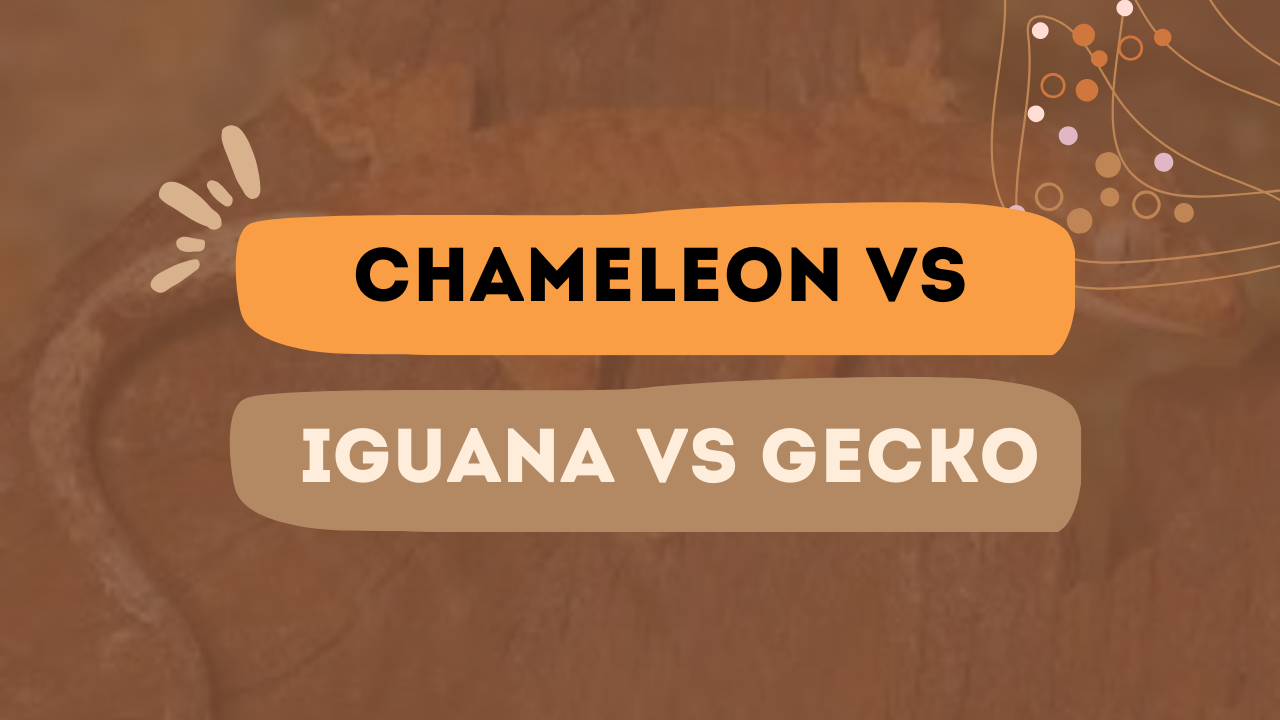Alright, let’s be honest for a moment. Did you ever wonder, “Wait… which one of these is this again?” when you saw a gecko, iguana, or chameleon? You’re not by yourself. If you’re not a complete reptile nut (no harm if you are; we adore that for you), the whole chameleon vs. iguana vs. gecko comparison can be a little perplexing. From a distance, they all appear somewhat alike—scaly, foreign, and strangely endearing. However, upon closer inspection, these three resemble the lizards’ representation of completely distinct personalities at a gathering. Let’s dissect it: who is the little sticky-toed ninja, who is the vegetarian gym guy, and who has the ability to change color? Let’s get started.
First Things First – What Are They?
Let’s begin by outlining the fundamentals.
Chameleon: Known for their skin that changes color, chameleon reptiles are considered to be the mood swings of the animal kingdom. They belong to the Chamaeleonidae family and are very distinctive due to their protruding, self-moving eyes.
Iguana: Members of the Iguanidae family, iguanas are large, laid-back, and sometimes confused for little dinosaurs. Like Florida retirees, they pass a lot of time in the sun and are primarily herbivores.
Gecko: The tiniest (and possibly most adorable) of the group, geckos are nocturnal insects. They are well-known for their clinging toe pads, which enable them to climb walls with ease. They are members of the Gekkonidae family.
Thus, it is true that lizards differ in their construction.
Size Matters
Alright, this is when things start to get crazy. The iguana prevails if size is your primary concern. Definitely. A green iguana can weigh about 11 pounds and reach a maximum length of 6.5 feet, including the tail. It’s a miniature dragon, not a lizard.
Chameleons? They are more humble. For instance, the maximum length of the panther chameleon is about 20 inches. Additionally, some kinds of chameleons are so little that they can fit on your fingertip. I mean, really.
Then there are geckos, which are the epitome of little. The Tokay gecko can grow up to around a foot in length, however most geckos are only 3 to 6 inches.
Therefore, you might want to pass on the iguana if you’re searching for a reptile that won’t outgrow your residence.
Diet Dilemmas
People are constantly surprised by this part. You would believe that all reptiles only consume insects. Not at all.
Iguanas are entirely plant-based. In the world of lizards, these people are comparable to vegetarians. They typically eat fruits, flowers, and leafy greens. Thank you very much; no bugs.
Chameleons: They enjoy insects. Worms, crickets, and even the odd little bird—yes, wild. They don’t like salads.
The majority of geckos are also insectivores. Depending on the species, geckos may consume mealworms, insects, and occasionally tiny fruits. They are somewhat adaptable, although bugs are undoubtedly a possibility.
Iguanas may therefore be your best option if you’re uncomfortable feeding live insects. Just saying.
Habitat Vibes
Now let’s discuss real estate. Each of these reptiles has a preferred kind of crib.
Chameleons require large habitats with lots of trees because they enjoy being in high areas. You can’t simply leave them in any tank because they’re extremely sensitive to stress.
Iguanas require large enclosures that allow for both vertical and horizontal climbing. Their fancy name for “likes to climb” is semi-arboreal, and they enjoy sunbathing in UVB rays.
Geckos are calmer. The leopard gecko and the majority of other pet geckos don’t even climb very high. However, a vertical layout is what you’ll want if you have a crested or tokay gecko.
Research is kind of essential here because each one has different care needs.
Personality and Behavior
Each lizard has a distinct personality, which makes this one challenging.
Iguanas are territorial but can also be laid back. While a well-mannered iguana may tolerate being handled, an irate one may bite or strike you with its tail. Not enjoyable.
Chameleons? Not adorable. Like the quiet creatures of the reptilian world, they are stunning and fascinating but don’t particularly enjoy being touched. Most of them just want to feel alone, although some can handle brief handling.
In general, geckos—especially those like the leopard gecko—are the friendliest. They appear curious, can withstand handling, and have adorable little smiles (well, maybe that’s just the way they look, but still).
Therefore, a gecko can be the perfect companion for you if you’re seeking for a reptile to hang out with.
Price and Maintenance
Let’s face it, owning a reptile is not inexpensive. Here’s a brief summary.
Depending on the species, chameleons can range in price from $60 to $300+. A sophisticated setup with watering systems, Ultraviolet lights, and a plenty of greenery is also required.
Iguanas are surprisingly inexpensive to purchase—and occasionally even free—but costly to keep. You’ll need plenty of space, lighting, heat, and a specially made enclosure.
Geckos: Most likely the least expensive. Leopard geckos range in price from $30 to $80, and their setups are much easier and less expensive to keep up.
If you’re new to caring for reptiles or have a limited budget, geckos are a great starting point.
Final Thoughts – Which One’s for You?
Who will win out then, between the chameleon, iguana, and gecko? Well, that is all up to you.
Do you enjoy a challenge and want something flamboyant and distinctive? Invest in a chameleon.
Do you want a large, laid-back, vegetarian lizard as a pet? Try an iguana, but be prepared to commit.
Do you want a nice, low-maintenance, and adorable little friend? The place to be is with geckos.
This is not a one-size-fits-all situation. Each has advantages and disadvantages, and the choice should be based on your experience, lifestyle, and financial situation.
Whatever you do, just make a commitment to provide your scaly companion with the affection (and heat lamps) they are due.

